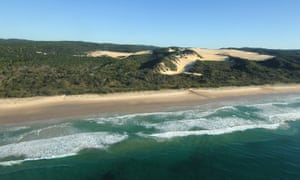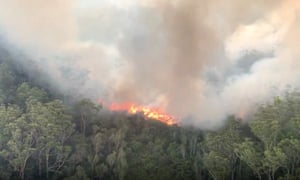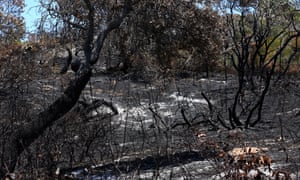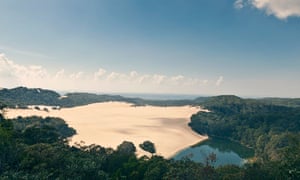Extract from The Guardian
Campaigners who helped end logging and mining in the spectacular paradise of lakes, rainforests and beaches now fear global heating
Before he died in February 2019, John Sinclair had been fighting for Fraser Island off the Queensland coast for the best part of 50 years.
In the early 1970s the world’s biggest sand island – an ethereal paradise of lakes, towering rainforests and ancient dunes – was under pressure from sand mining and more than a century of logging.
By 1976, Sinclair and his purpose-built Fraser Island Defenders Organisation (Fido) had fought off the sand miners. It took another 15 years for the logging to stop.
But in the years before he died, there was another threat to the island’s future that Sinclair was worried about. Climate change.
Two months ago, an illegal campfire on the island got out of control. With drier than usual conditions and high temperatures, the blaze has so far scorched 85,000 hectares – more than half the island.
What would John Sinclair have made of the devastation?
“He’d probably have said: I told you this would happen,” his son Keith tells the Guardian. “He’d say: What are we going to do to make sure it won’t happen again?”
After logging ended, the island was inscribed as a United Nations world heritage site in 1992.
“When the logging stopped I said to dad that we’d won,” Keith Sinclair says. “He said we hadn’t, because now the island would be loved to death.”
With tourism comes impact
Fire has always been a feature of the island’s landscape, and many species have evolved to exist with fire.
The Butchulla Aboriginal people have lived on the island for thousands of years and traditionally carried out cool patch burns to promote biodiversity and reduce the risk of larger fires.
Europeans and loggers arrived in the mid-19th century.
The Butchulla people were dispersed, put in missions and, in at least one documented case from 1851, massacred.
Thousands of years of fire management ended and the island’s susceptibility to fire – known as the fire regime – changed.
At the same time, the island’s ecology was being affected by logging and sand mining.

Peter Shooter, the current president of Fido, says the organisation fought strongly in the 70s and 80s for a future based not on extraction and destruction, but on eco-tourism.
“We were laughed out of town by supporters of the mining and logging industries all the way through that,” says Shooter. “The tourism industry has grown huge, and with that industry comes impact.”
Earlier this month, the International Union for Conservation of Nature released its latest outlook report for K’gari, as the island is called in local language.
Among the many threats facing the island, it reported, were disturbances from the many thousands of 4WD vehicles that drive along the island’s beaches and along sand tracks, and from the hundreds of thousands of visitors each year.
Shooter says: “Fido finds itself in a position where we advocated for a shift in the island’s economy and now we have to live with the consequences.”
A Queensland government statement said about 600,000 people visit the island each year and more than $10m was budgeted annually for management activities “including maintaining and improving visitor infrastructure and education messaging aimed at protecting and presenting the island’s world heritage values”.
Four full-time Butchulla land and sea rangers were funded and who undertook planned cultural burns, the statement said.
Ancient dunes
K’gari covers 160,000 hectares, with 250km (155 miles) of beaches. Dingoes move through beaches, dunes and forests, birds of prey and shorebirds survey the coastlines and the dense rainforests, creeks and banks are home to lizards and small marsupial mammals.
Half the world’s freshwater dune lakes are on K’gari. The island’s towering 50m rainforest trees on the top of coastal dunes are thought to be unique globally.
“They are the most spectacular and complex series of coastal dunes in the world and they have a history going back 800,000 years,” says Prof Jamie Shulmeister, who has studied the long history of the island’s sand dunes.
Shulmeister, who moved from the University of Queensland to New Zealand’s University of Canterbury in February, most recently chaired the K’gari world heritage scientific advisory committee, which is currently being reconstituted.
“[The dunes] go inland and individual dunes can be five or 10 kilometres long and several hundred metres high.
“Coastlines are really dynamic places and it’s unusual to have dunes that keep reforming in the same place at the same time.”

The island’s heathlands and eucalypt forests give way to spectacular rainforests through the middle of the island, where trees more than 1,000 years old tower above crystal clear creeks.
Shulmeister says those rainforest ecosystems existed because the dunes had been in the same place for so long.
But the IUCN outlook report says climate change is an emerging threat to the island’s unique features that were the basis for its world heritage listing.
“Climate change seems to be irreversibly changing some of the physical properties of the site and has already been demonstrated as a threat to several site values,” the review says.
Increasing temperatures were threatening some plant species, rising sea levels could erode the dunes, and worsening droughts, more intense rainfall and bushfires are all lining up to put further pressure on the island’s ecology.
Myrtle rust – an invasive plant disease – is also well established on the island, affecting melaleuca swamps and fringing rainforest trees.
Fires are getting larger
In August, bushfire experts issued an outlook for Australia.
Most of the country faced a normal level of risk from fire, but the south-east of Queensland – including K’gari – was predicted to be at higher risk because of low rainfall over the past two years.
The Queensland premier, Annastacia Palaszczuk, has ordered a broad review into the fire.
At the peak of the firefight, 14 water-bombing aircraft were being used daily, with 90 firefighters from the Queensland Fire and Emergency Services, Queensland Parks and Wildlife service and the Butchulla Aboriginal Corporation.
Firefighters are hopeful that heavy rainfall forecast for several days from Saturday could finally put the blaze out.

Shulmeister says fires have been getting larger and burning hotter in recent decades than at any time during European habitation.
“They become a threat to the ecosystems and the plants and animals. I’m dismayed by the size and scale [of the latest fire],” he says.
Many of the island’s ecosystems are adapted to cope with some fire, but it will be some time before ecologists know how the scale and intensity of the fire affects the recovery.
“If we get a period where the island can recover then it might not be such a big deal,” Shulmeister says.
“But if in one or two years there’s follow-up fires, you will see erosion of the sand dunes and that could be a major change on the island.
“This could be an event that triggers major sand movement, but we won’t know until it’s in the rear vision mirror. It’s big enough that this could be the start of something dramatic.”
‘The animals can’t escape’
Keith Sinclair’s grandparents had their honeymoon on the island in 1935 and built a house near Eurong on K’gari in the 1960s.
Sinclair’s childhood memories are filled with long K’gari days, and he still visits several times a year, taking his own two children.
“What terrifies me is the extent of the fire,” he says. “The animals can’t escape.”

Fido has built a series of small weather stations around the island because Sinclair says his father was convinced the island was drying out.
Shooter says Fido wants more done to mitigate the damage being caused by visitors, and has even proposed a light rail line to take in key locations and to reduce the pressure from 4WDs.
Shooter believes the duration and size of the fire is unprecedented, but whether climate change was a factor he can’t say definitively.
“These are matters for international action and we all suffer the consequences unless all of humanity plays its part. There’s very little Fido can do, but we’re in this and we’ll be making representation to the Australian government to lift its act.”
.png)

No comments:
Post a Comment